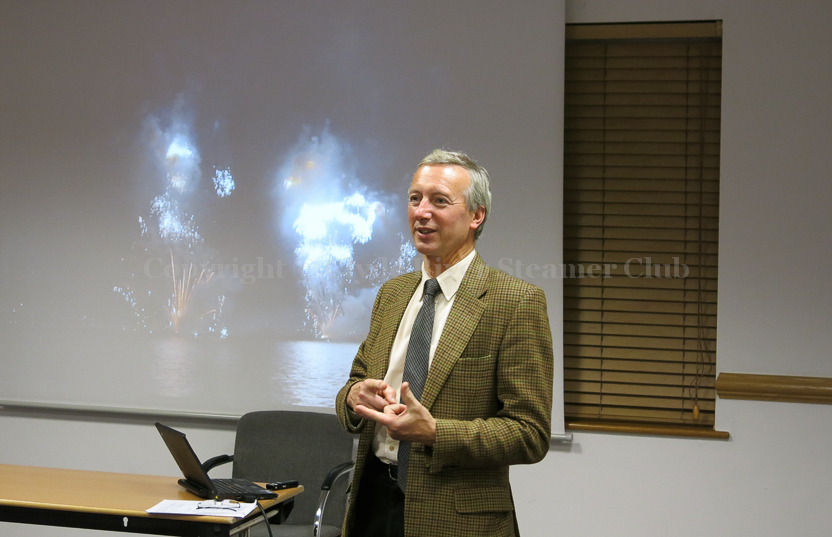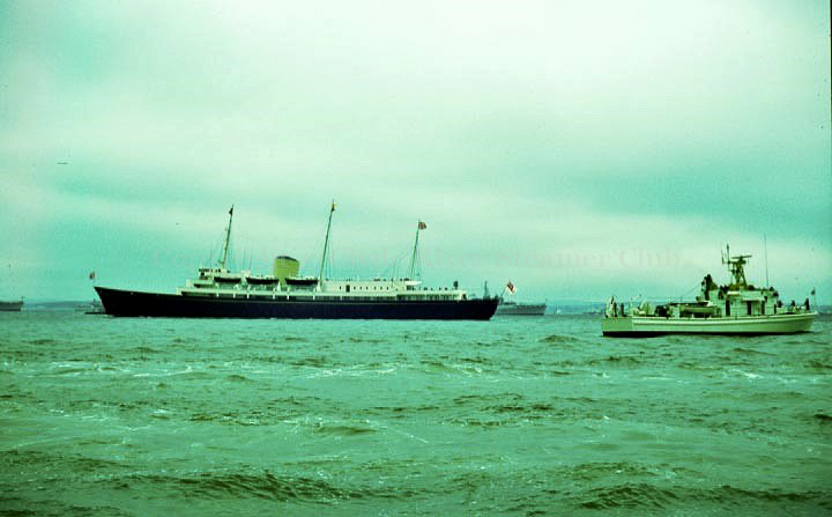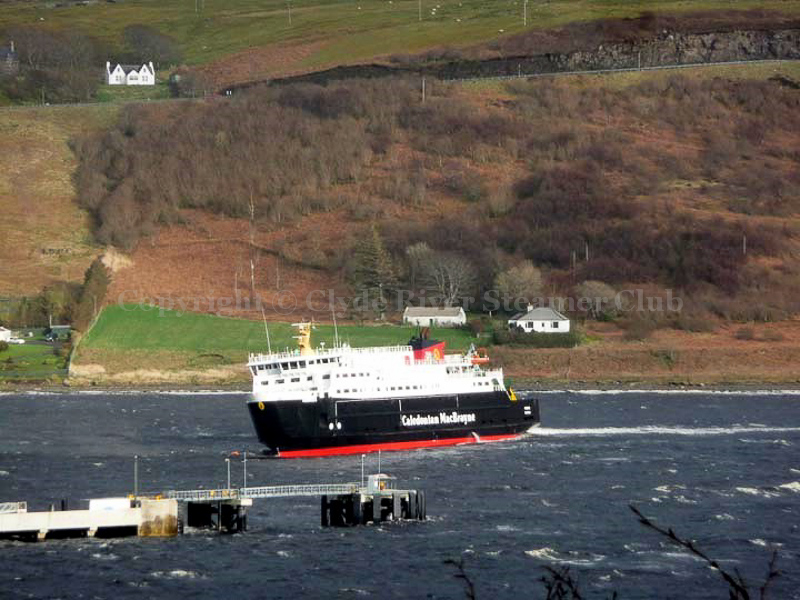The first meeting of the CRSC’s 2014-15 session took place at Jurys Inn, Glasgow, on October 8
From a helicopter’s view of HMS Fearless on active service to ship-to-ship fuel transfer on the high seas, from the uneasy tranquility of Ascension island to an exploding warship in the South Atlantic, from a 30-knot steam turbine frigate to HMS Illustrious’s visit to Japan — these snapshots of life in the Royal Navy suggest the CRSC’s new president brings a breadth and depth of maritime experience far beyond the ken of most Club members. And yet throughout Angus Ross’s talk on October 8, inaugurating his two-year term in the president’s chair, all such exploits seemed to pale next to his love of the Hebrides: his whole life seems to have been shaped by the ships and personalities of western Scottish waters, which have given him a constant reminder, from near or afar, of his roots and core interests.
 |
 |
 |
 |
| The 1964 Hebrides at Uig | MacBrayne ‘car ferry’ Lochdunvegan | Loch Arkaig at Portree | Hallaig at Armadale |
Titled ‘One Striper to Broad Pennant — Memoirs of the Commodore’, Angus’s talk was an enthralling ‘tour d’horizon’ embracing King George V and Finlaggan, childhood holidays in Skye and professional experience of the Falklands and Faroe Islands, from the bridge of the 1964 Hebrides to the landing platform of HMS Fearless and the cramped submarine accommodation of HMS Oberon.
Angus’s distinguished naval career, until his recent retirement with the rank of Commodore, provided an impressive foreground for much of his talk, but there was never any doubting the wider context in which he saw his professional adventures. That context was the family croft at Uig, the arrival of Loch Arkaig at Portree, the taste of ‘jam roly-poly’ on the 1964 Hebrides, the spectacle of cars being loaded by crane onto the MacBrayne cargo ship Lochdunvegan, the sight of KGV’s polished engine dials — not forgetting the movements of the present CalMac fleet.
All this was delivered with Angus’s trademark geniality, fluency and wit — a round-the-world trip in 70 minutes, spoken without so much as a note.
We were treated to pictures of the precarious Kylerhea ferry and to memories of the ferry crossing at Kyle, where the Ross family (headed by Angus’s late father Willie, a longtime CRSC member) were sometimes held up for two hours after a day-long drive north on the old road from Glasgow. Despite the wait, the old four-car ferries “were wonderful value for local folk — I don’t ever remember seeing my father handing over money”.
Angus also recalled the impact of the first MacBrayne car ferries, noting that the arrival of Hebrides at Uig 50 years ago revolutionised transportation across the Minch “and revolutionised my life as well”. Such was his attachment to the ship that he loyally followed Hebrides’ post-MacBrayne history, sailing on her out of Torquay (as Devoniun) and noting that she is the only MacBrayne ferry to have crossed the Atlantic (to St Vincent and the Grenadines in 1999). Angus also became familiar with Clansman at Armadale (“she was never particularly busy”) and Columba out of Oban — though his experiences there and on the Clyde in the early 1970s were dominated by King George V, a ship that was “loved by Willie, and influenced me tremendously”.
Coinciding with the King George’s withdrawal in September 1974, Angus joined the Royal Navy — though even here, his steamer interests kept cropping up: his ‘passing out’ ceremony at the Royal Naval College at Dartmouth conveniently coincided with the refit of Balmoral at Kingswear and the pre-demolition lay-up of Loch Eynort on the River Dart.
Thereafter the tempo of life for sub-lieutenant Ross speeded up. We were treated to the sight of HMS Fearless’s internal dock for landing craft (some of which ended their days as fish farm boats on Skye), a bull-fight at Cartagena, the steam turbine frigate HMS Rhyl, and the 1977 Dartmouth fleet review with Royal Yacht Britannia. Less glamorous were the storm-tossed cod patrols in the Iceland/Faroes Gap and the smells of cabbage and diesel on submarines. Then there was the 1982 Falklands experience, which included the spectacle of ‘the great white whale’ (the requisitioned P & O liner Canberra), the sound of HMS Ardent being blown up, the arrival at Port Stanley of British Rail’s cross channel ferry St Edmund and the transformation of Uganda from hospital ship to prisoner-of-war ship.
Various shore-based appointments were intermingled with glimpses of Rhu na Gal from HMS Galatea, of Maid of Cumbrae and City of Hydra ex-Claymore during a Mediterranean tour of duty, and of former Clyde sludge boat Shieldhall at the 2004 naval review on the Solent. As logistics commander on HMS Illustrious, the mighty Invincible-class aircraft carrier, Angus served in the Gulf and at the handover of Hong Kong.
 |
 |
 |
 |
| HMS Ardent goes under | Shieldhall at the 2004 review | HMS Illustrious | The ‘fairly photogenic’ Finlaggan |
Closer to home and the present day, Angus indicated that sailing on the modern CalMac fleet gives him just as much satisfaction as life on the ocean wave. We were regaled with pictures of the ‘butty bus’ at Leverburgh, of Hebrides’ list after a “handbrake turning in Uig Bay”, of Hallaig at Armadale, Eigg at Portree and Raasay at Raasay. Finlaggan, which last year relieved Hebrides on the Uig triangle, is known as “the windy wee boat — not the favourite ship for that route though she can be fairly photogenic and she has a lot of bling inside”. One of Angus’ many ‘collector’s items’ was a shot of Finlaggan in Uig Bay together with Arrow, the Maltese-flagged freight ferry, which had been undergoing trials for possible use as a back-up.
In his vote of thanks, immediate past president Deryk Docherty described Angus’s address as “a memorable night in the annals of the Club” — a sentiment heartily endorsed by all present. The meeting was chaired by CRSC vice-president Iain Morgan and drew a full house. The next meeting is on November 12.






























